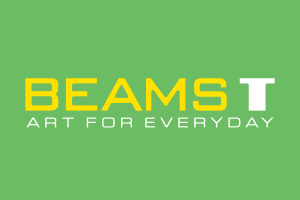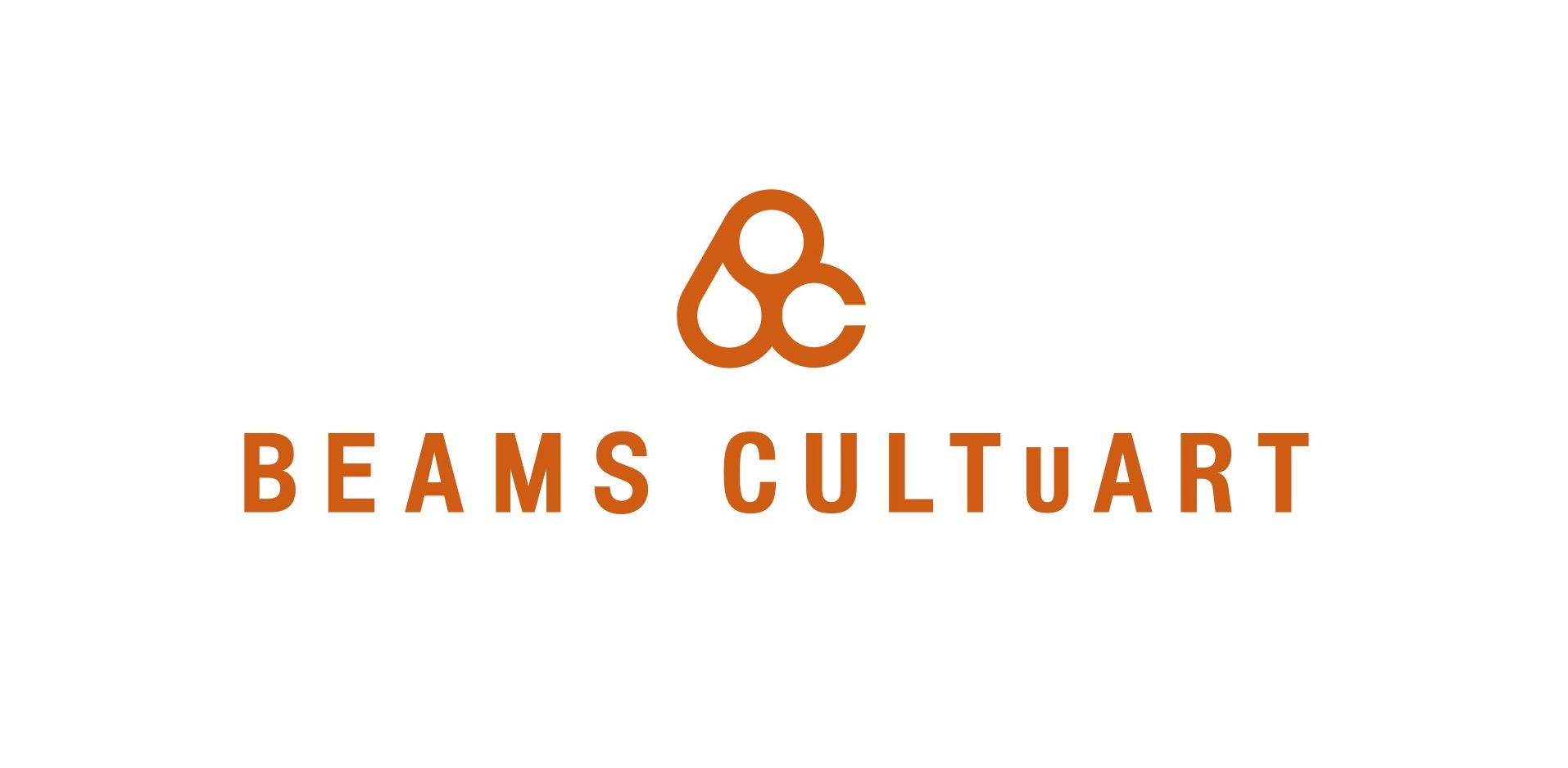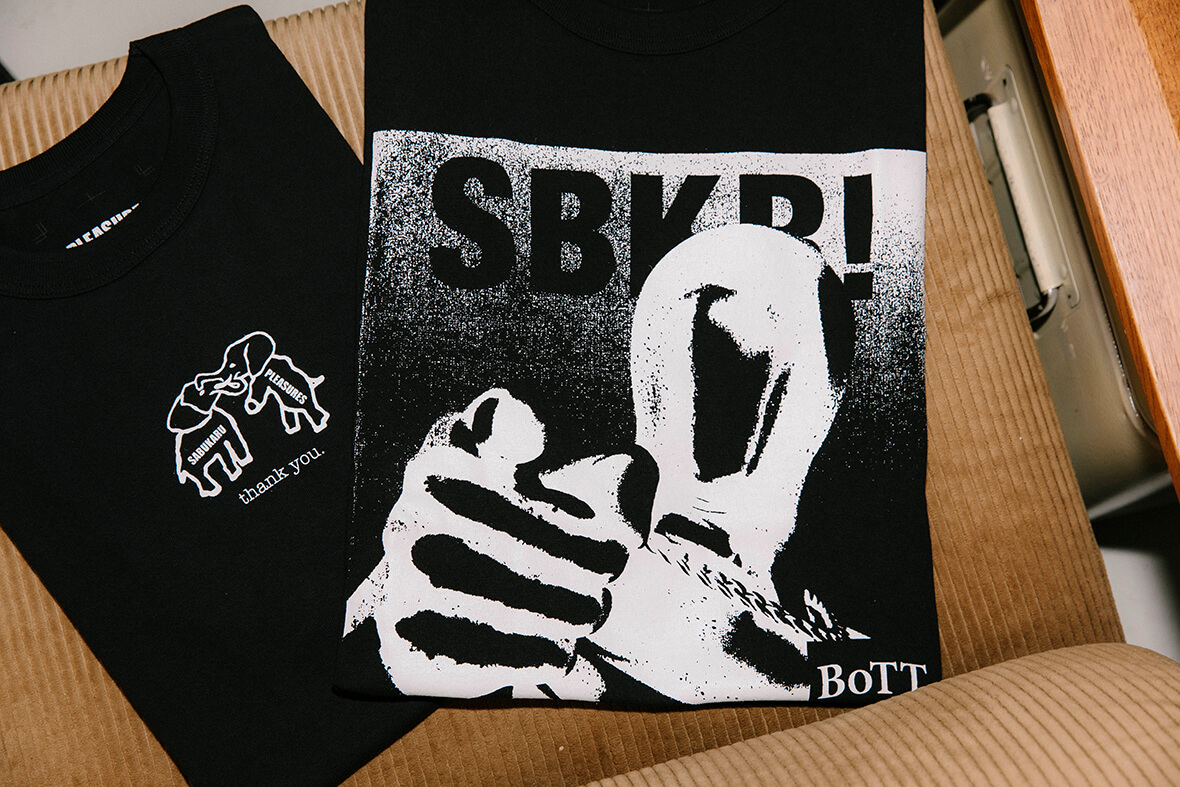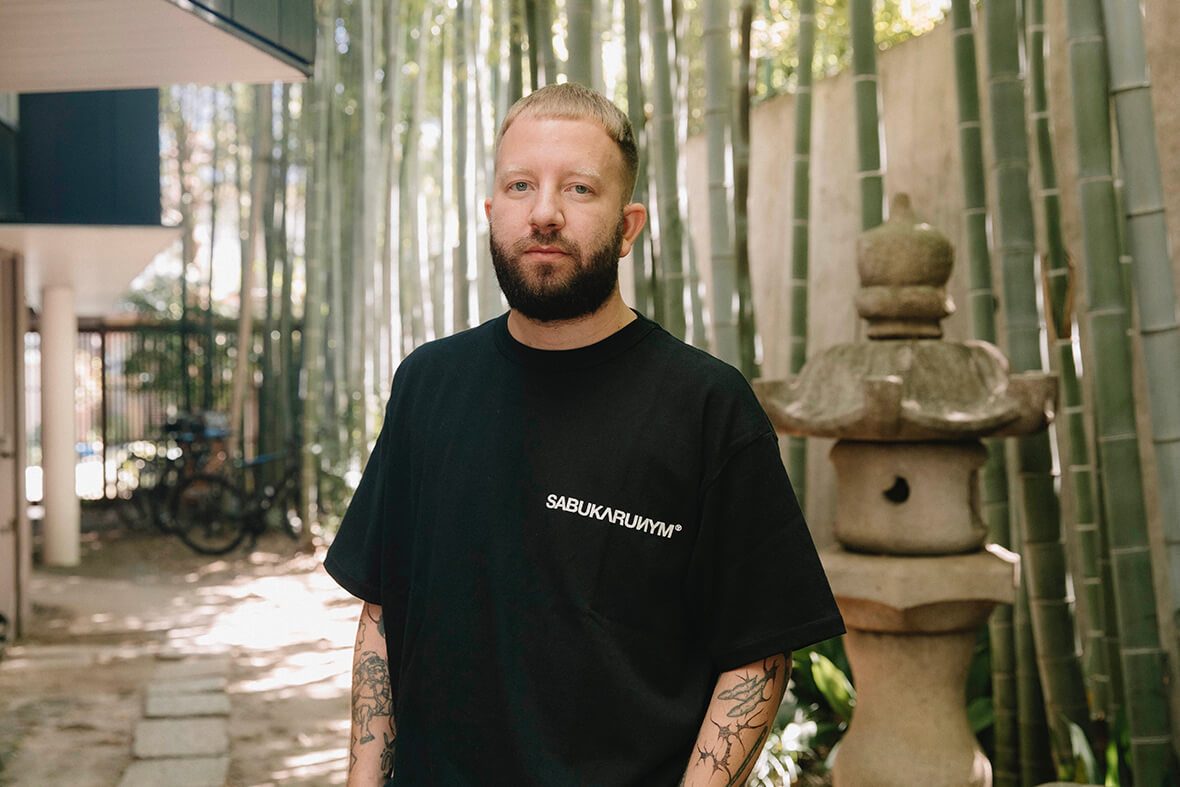

広がり、繋がる日本のサブカルチャー。
Spreading and connecting Japanese subcultures
ファッションデザイナーへのインタビューから、ニッチなマンガやアニメの紹介まで、日本のサブカルチャーを切り口に、さまざまなトピックを海外へと発信する『サブカルオンライン(sabukaru.online、以下sabukaru)』。いま、日本の若者を中心に絶大な人気を集めているウェブマガジンですが、その世界観に惹かれたのは〈ビームスT〉も同じ。今年の7月には、『sabukaru』とタッグを組み、「ビームスT 原宿」で合同展を開催しました。今回は、このイベントを企画したキーマン2人に、日本のサブカルチャーの話や、合同展を開催するに至った経緯について、語ってもらいました。
From interviews with fashion designers to introductions of niche manga and anime, "sabukaru.online (hereafter "sabukaru")" is a web magazine that introduces a variety of topics to the world, with a focus on Japanese subcultures. The web magazine is currently extremely popular among young people in Japan, and BEAMS T was drawn to its worldview as well. In July of this year, we teamed up with "sabukaru" to hold a joint exhibition at BEAMS T Harajuku. We asked the two key figures who organized this event to talk about Japanese subcultures and how they came to hold this joint exhibition.
PROFILE

左:エイドリアン・ビアンコ
(サブカルオンライン 編集長)
ドイツ出身。個人ブログを前身に、2018年からウェブマガジン『sabukaru』を始動。メディアの運営にとどまらず、ブランドのビジュアル制作やコンサルタント業など、幅広いフィールドで活躍中。
WEBサイト
Instagram:@sabukaru.online
右:金子貴文
(ビームスT 原宿 スタッフ)
愛媛県出身。2014年にBEAMSへ入社。現在は「ビームスT 原宿」でVMDや店舗マネジメントなどを手がけ、商品企画にも携わる。音楽やアートなどのストリートカルチャーへの知見が深い。
Instagram:@tk23____
世界を魅了する日本のサブカルチャー。
―まずは、おふたりが出会った経緯から教えてください。
金子:2年ほど前、渋谷にある「ブルールーム(blueroom)」という古着屋で『sabukaru』のメンバーの夏樹と仲良くなって。彼からビアンコさんを紹介してもらったんです。
―金子さんはその頃から『sabukaru』のことをご存知でしたか?
金子:もちろん。当時もいまと変わらず、海外視点で日本のサブカルチャーを紹介していて、他にはないウェブマガジンという印象でした。

―『sabukaru』がスタートしたのは、たしか2018年ですよね?
ビアンコ:それが少しあいまいで。ぼくは2018年に日本へ移住してきましたが、ベルリンにいたときから日本のサブカルチャーをテーマにした『Biancissimo』というブログを個人的にやっていたんですよ。それが『sabukaru』の前身になっていて。
―いまの『sabukaru』と内容に違いはありましたか?
ビアンコ:似ているようで、違っていましたね。例えば、『Biancissimo』では、〈ナナミカ(nanamica)〉代表の本間永一郎さんから、とある居酒屋の大将まで、気になるひとのインタビュー記事を掲載していました。それはいまの『sabukaru』と通ずるところがあります。ただ、『Biancissimo』の方が、ぼく個人の興味がより反映されていたような気がします。
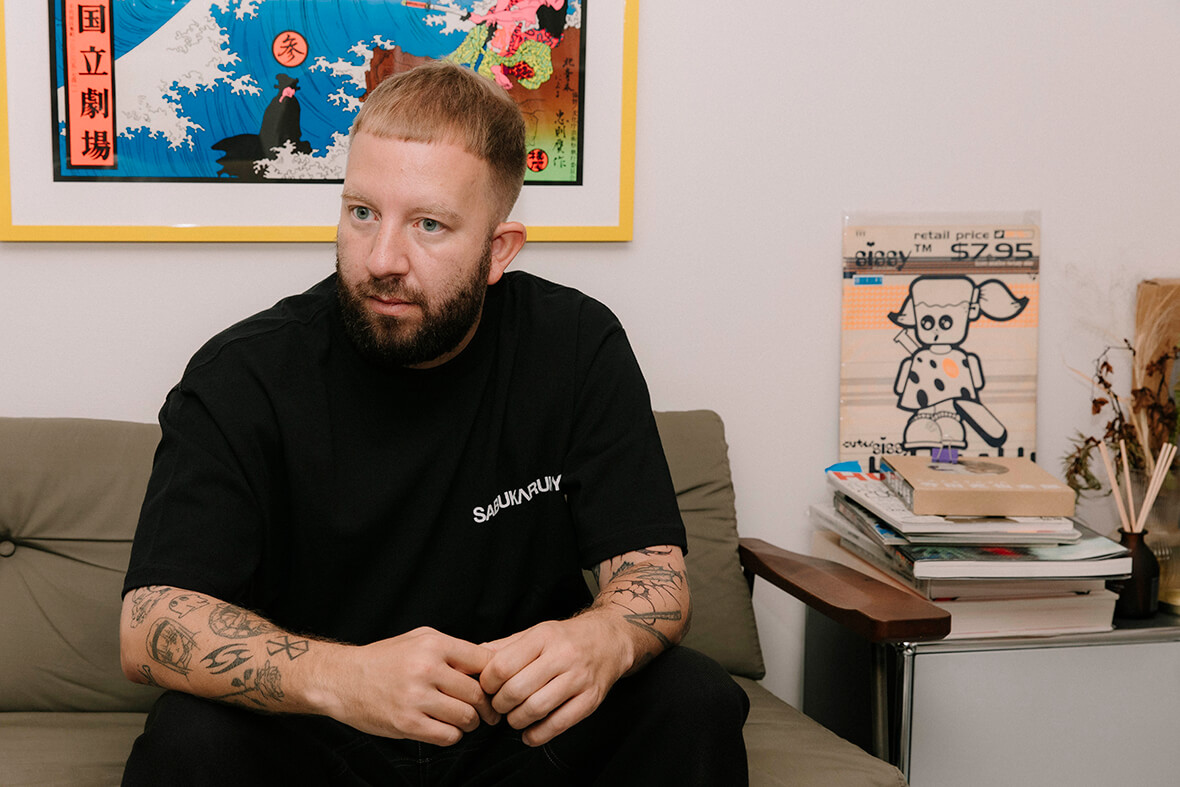
―そもそも、ビアンコさんが日本のサブカルチャーに興味を持ったきっかけはなんだったんですか?
ビアンコ:思い返せば、ドイツに住んでいた子どもの頃から日本のカルチャーや食事が大好きでした。明確に好きになったのは、『ドラゴンボール』がきっかけかな?
金子:やっぱり『ドラゴンボール』は海外でも人気なんですね。ぼくも小学校低学年のとき、たまたま「アニマックス」で放送していた『ドラゴンボールGT』から入って、その後『ドラゴンボールZ』も好きになりました。
―ビアンコさんから見て、日本のサブカルチャーのどこに魅力を感じたんですか?
ビアンコ:日本のサブカルチャーには、魅力的なソフトパワー(自国の価値観や文化によって相手を魅了する力)があると思うんです。だから、いまとなっては日本のサブカルチャーが、海外のメインストリームにも取り入れられることも多いですよね。例えば、リル・ウージー・ヴァートのアルバム『Pink Tape』に「ベビーメタル(BABYMETAL)」がフィーチャリングで参加したみたいに。
―ちなみに、ビアンコさんの好きな日本のサブカルチャーは?
ビアンコ:好きなものが多すぎて、ひとつに決められない(笑)。少しでも時間が空いたら日本のインディーズ映画やマンガをチェックしているし、いろんなことに関心が向いているので。強いて言うなら、日本の食文化は一貫して好きですね。最近だと、池尻大橋にある「不二」という鉄板焼き屋さんがお気に入りです。
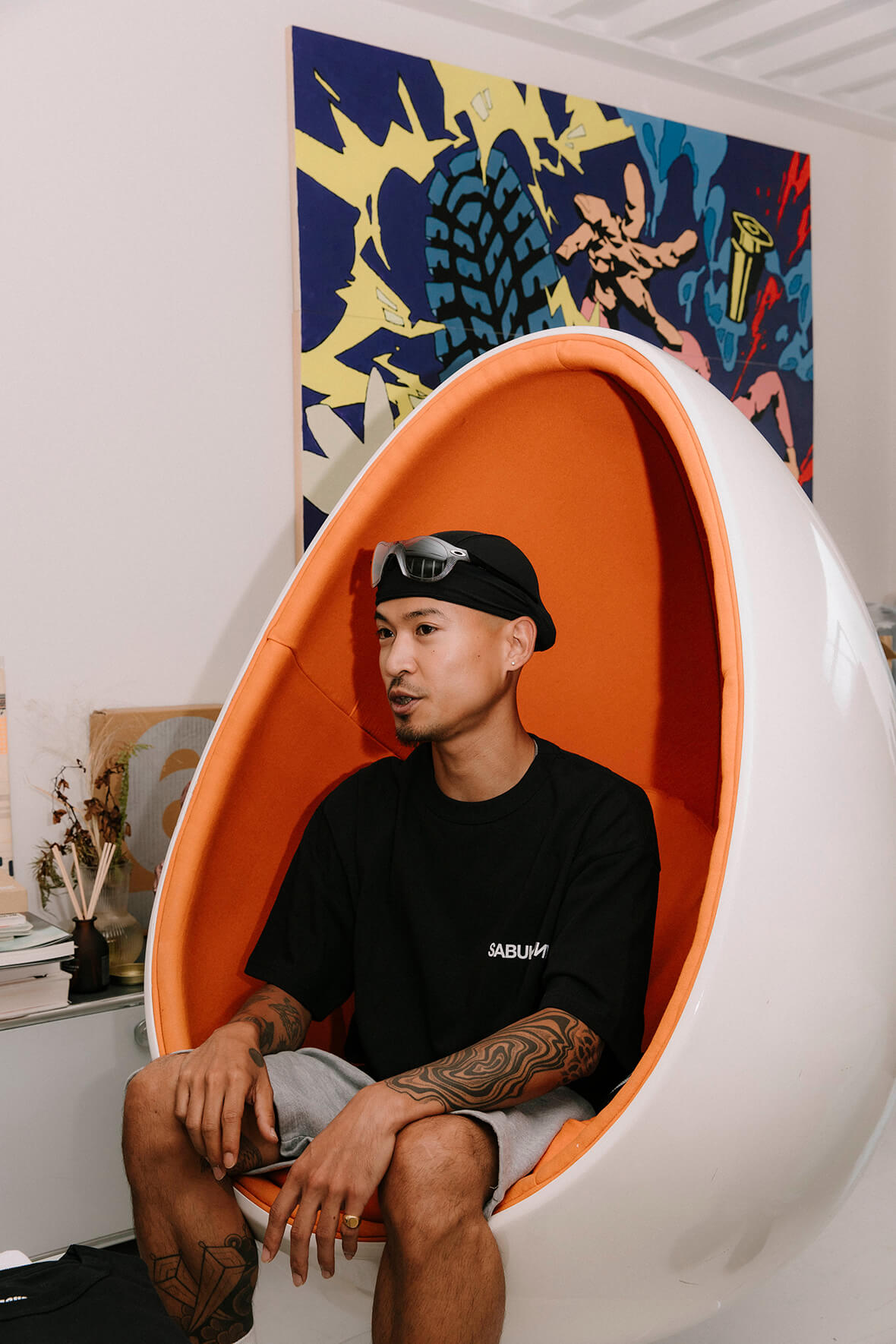
金子:サブカルチャーってひと言で言っても幅広いから、ひとつに決められないですよね。ぼくはファッションを入り口に、その背景にある音楽をディグるのが好きです。
―ファッションと音楽は密接に繋がっているサブカルチャーですよね。
金子:そうですね。UKラッパーのスケプタは、昔からトラックスーツみたいなスポーツ用品店に売っている服をかっこよく着ていますけど、それが彼のやっているグライムというジャンルとちゃんと結びついている。世界的ヒットを飛ばしている中でもスタイルは変わらないし、いまそれがテック系のようなひとつのファッションのトレンドになっているのがおもしろいと思います。
sabukaruが見据える先。
ー『sabukaru』で取り上げているトピックも、ファッションや音楽、マンガ、アニメ、ゲーム、アートなど多彩です。各ジャンルのなかでも、ピックアップする基準はありますか?
ビアンコ:まずひとつ挙げるなら、どれだけ深掘りできるか、ということ。海外で日本のサブカルチャーが人気と言っても、現地のウェブメディアで紹介されているのは誰もが知る定番ばかり。例えば裏原ファッションだったら、〈ア ベイシング エイプ®️(A BATHING APE®)〉のNIGO®️さんや〈アンダーカバー(UNDERCOVER)〉の高橋盾さん。でも、裏原には〈スワイプ・オン・ザ・クワイエット(SWIPE ON THE QUIET)〉の千壽公久さんのようなあまりメディアでは紹介されていないひともいますよね。だから、ほかではピックアップされていない、かつ深掘りできるトピックを、日本で直接調べたり取材したりしながら海外に発信するように心がけています。
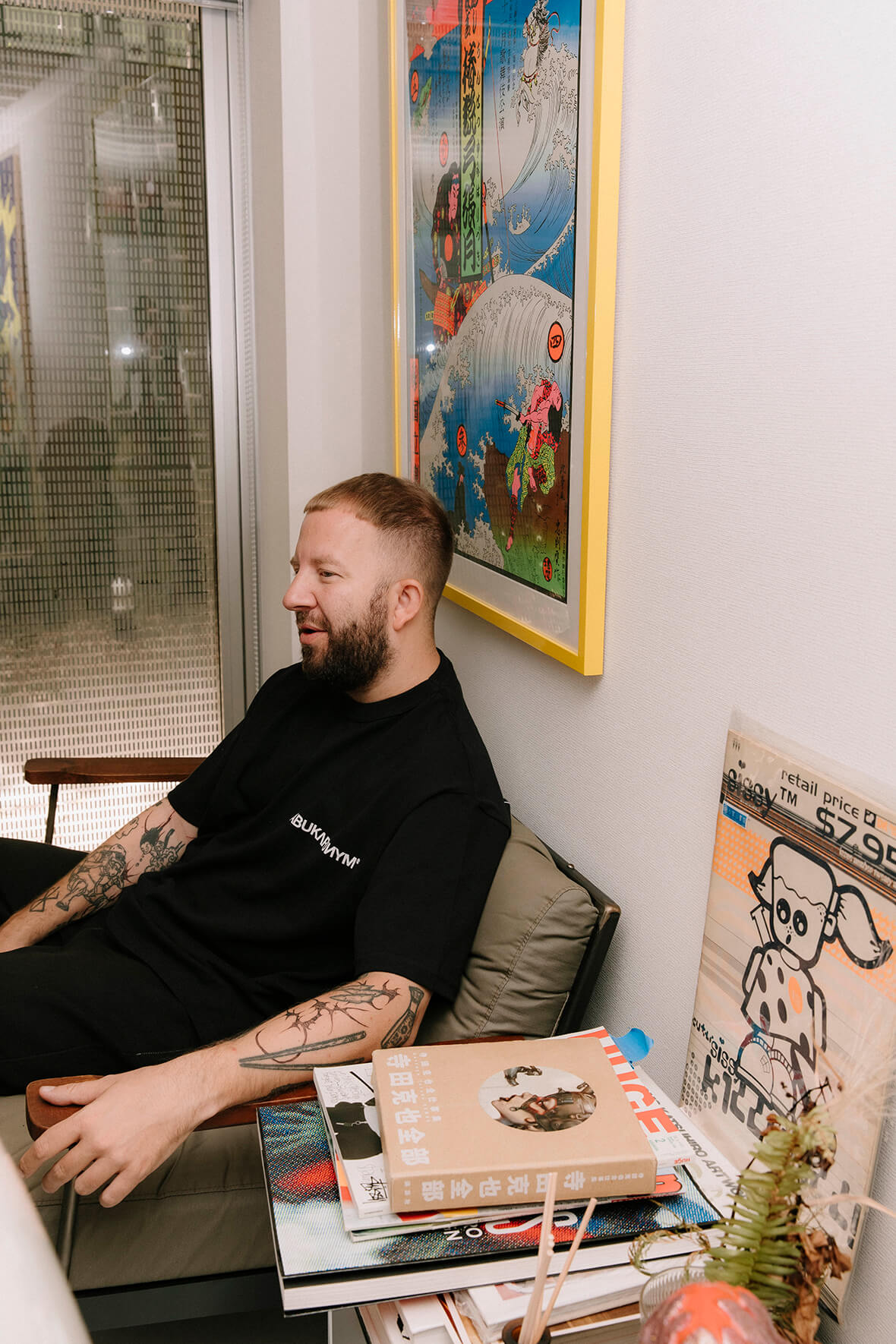
金子:日本人も、特に若い世代は『sabukaru』の情報を新鮮に受け取っていると思いますよ。2000年代初頭だったらナードなイメージだったアニメや漫画も、センス良くファッションに落とし込んでいるので。
ビアンコ:移住して5年経ち、まだ世界に知られていない日本の素晴らしいサブカルチャーもたくさん発見したので、さまざまなコンテンツを多角的に取り上げていきたいと思っています。その中でも、行きつけの銭湯の女将さんにインタビューするのが、ひとつの夢なんですよ。
『sabukaru』の事務所内の本棚。『キューティー』『アサヤン』『チャンプロード』など、日本の雑誌のアーカイブが多数並んでいる。
―自身の興味を純粋に取り上げているんですね。
ビアンコ:ぼくらは『sabukaru』と並行して、「ビアンコ ビアンコ(BIANCO BIANCO)」という別会社でブランドのビジュアル制作などをやっているから、『sabukaru』では大きな利益を求める必要がないんです。そのおかげで、アダルトな内容や社会の闇など、少し過激なコンテンツも記事化できています。
金子:日本のウェブメディアではなかなか見られないトピックを取り上げているのが、『sabukaru』の魅力ですよね。
―ビアンコさんは今後、『sabukaru』をどんなメディアにしていきたいですか?
ビアンコ:『sabukaru』はウェブマガジンですが、一種のマインドセットと考えてもらいたいです。サブカルチャーを吸収して自分の個性にしていく若者が、これからもっと増えていくはず。ひと昔前、新たなユースカルチャーを形成したウェブマガジンと同じような影響力が、いまの「サブカル」にあると感じています。そのためにも若い世代が喜ぶニッチなサブカルチャーを発信していきたいです。
国も世代もジャンルも超えて繋がった合同展。
―今年の7月に「ビームスT 原宿」で開催された、『sabukaru』のキュレーションによる合同展の話も聞かせてください。まず、開催のきっかけはなんだったんですか?
金子:去年、『sabukaru』が「スパゲッティ(SPAGHETTI)」というギャラリーで開催したポップアップストアにお邪魔してみたら、そこでコラボレーションしていたブランドやアーティストがとてもよかったんです。それを〈ビームスT〉のフィルターを通せば、また違う表現ができて、互いの刺激になると思いまして。
ビアンコ:そのときは“キオスク(KIOSK)”をテーマにしたポップアップストアだったんですが、それが『sabukaru』の初めてのリアルイベントでした。コラボしたのは、〈カーサービス(CarService)〉や〈エフエーエフ(FAF)〉、VERDYさんに「小宮山書店」などジャンルはさまざま。彼らとタッグを組んでアパレルや小物を販売したんですよ。オープンから30分ほどで会場にひとが溢れて、『sabukaru』のコミュニティが形成されていることに感激しました。
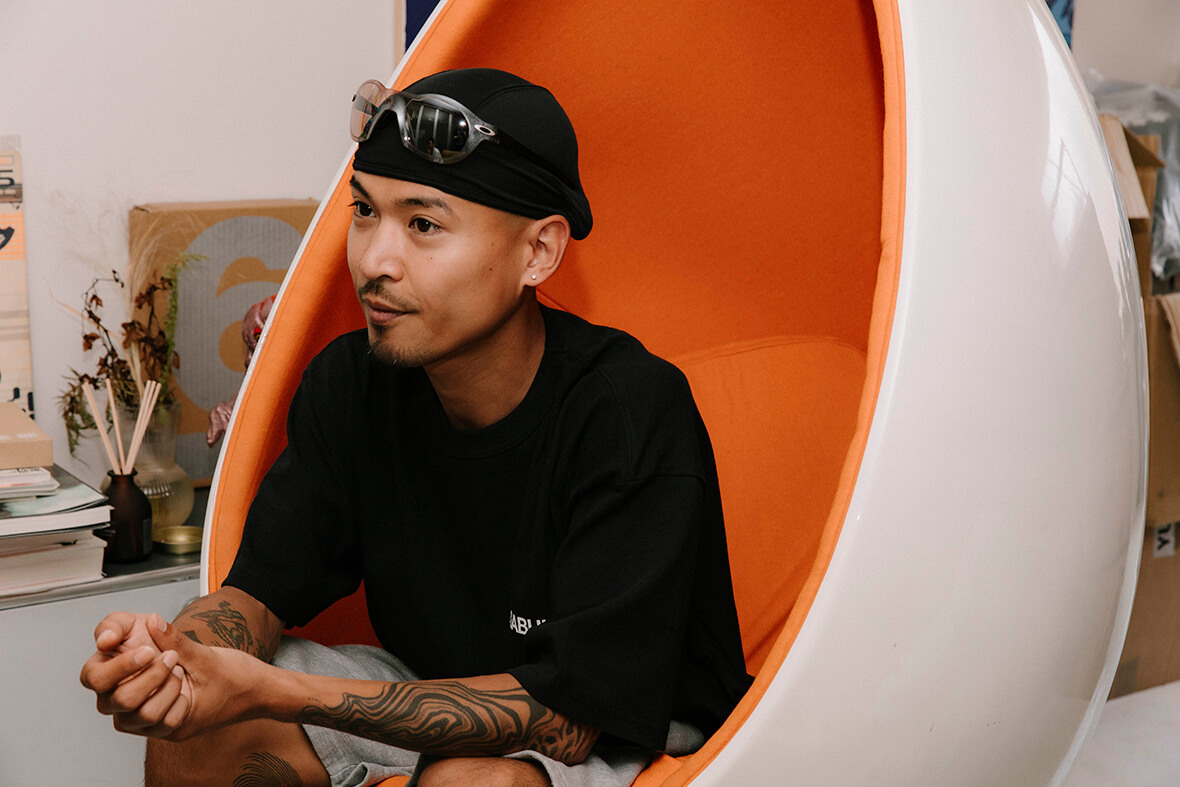
金子:新鋭からベテランまでのアーティスト、ディープからポップまでのカルチャーを網羅しているところが、〈ビームスT〉と通じるところがあるなと感じて。ぼくは当時「ビームス 原宿」に所属していましたが、直接〈ビームスT〉のディレクター水村とバイヤー佐藤に相談したら、合同展の開催に賛同してくれました。それで実際にビアンコさんとミーティングすると、「幅広くコラボレーションしたい」と言っていましたね。
ビアンコ:“コネクティング・カルチャーズ”、つまりカルチャーの繋がりが、『sabukaru』に秘めているコンセプト。ハードコアパンクのレジェンド、YOYO-TOMEさんが若い世代と一緒にパーティをしているように、世代を超えて、いろんなカルチャーが共存しているイベントを〈ビームスT〉でやりたいと思いました。
金子:それで合同展のテーマは、“Past, Present, Future (過去、現在、未来)”に。
ビアンコ:〈ビームスT〉と『sabukaru』、そして、ブランドやアーティストとのトリプルネームでTシャツをつくることになって。〈アクロニウム(ACRONYM)〉から、LAの〈プレジャーズ(PLEASURES)〉、裏原世代の千壽さんが手がける〈アッパーフィールドワン(UPPER FIELD ONE)〉、10代のグラフィティライターの兄弟、SHART & BAHKまで、いろんなカルチャーを繋げていくイメージで9組をキュレーションしました。
金子:個性が違うブランド、アーティストが揃ったと思います。方向性が違うように見えて、ちゃんと『sabukaru』というフィルターを通してまとまっている。異なるジャンルだからこそ、“コネクティング・カルチャーズ”を体現できたと感じています。〈アクロニウム〉など、これまでBEAMSでお付き合いがなかったブランドやアーティストとコラボレーションできたのも新鮮でした。
Tシャツには、6月に発表した〈ビームスT〉のオリジナルボディを使っていて。7月にローンチ記念として30組のアーティストやブランドとコラボレーションしましたが、イベントでこのボディを使用したのはこれが初めてなんです。あと、合同展の会場では、アートの展示販売も行いましたね。

取材当日、ビアンコさんが着ていたのは、今回の取り組みで制作した〈アクロニウム〉とのコラボTシャツ。
―実際に〈ビームスT〉と企画を進行してみて、いかがでしたか?
ビアンコ:〈ビームスT〉には0から100までのノウハウがあって、クオリティの管理ができていたから、夢のようなクリエイティブができました。
―イベント初日には、店頭でレセプションパーティを、渋谷の「エンター(Enter)」ではアフターパーティーも開催しました。
金子:『sabukaru』の注目度が高いので若い世代がたくさん来てくれたし、日本に住んでいるビアンコの友達の外国人や普段BEAMSで買い物をしていないひとたちも集まってくれて大盛況でした。日本の若い世代も『sabukaru』を通じて、日本のサブカルチャーのクールさを再認識しているように感じて。BEAMSだけではそこにたどり着かないと思うから、この合同展を開催してよかったです。
ビアンコ:これまでの活動の中でも、『sabukaru』のハイライトと言えるほど楽しいイベントでした。この合同展は、友達同士でおもしろいことをやろう、と始まったプロジェクト。リスペクトし合っている仲間とカルチャーを形成していきたいという想いが土台にあったので、とても楽しかったし、とてもスムーズでした。この合同展が、これから続いていくストーリーの第一章になるように、『sabukaru』と〈ビームスT〉の関係を深めていきたいですね。
PROFILE

Left: Adrian Bianco
(Editor-in-Chief, Subculture Online)
Born in Germany. He initiated the web magazine “sabukaru” in 2018, which had formerly been his personal blog. In addition to media management, he is active in a wide range of fields, including brand visual production and consultancy.
https://sabukaru.online/
Instagram:@sabukaru.online
Right: Takafumi Kaneko
(BEAMS T Harajuku Staff)
Born in Ehime, he joined BEAMS in 2014. He currently plays a role in VMD and store management at BEAMS T Harajuku, as well as product planning. He possesses a profound knowledge of street culture, including music and art.
Instagram:@tk23____
Japanese subculture fascinates the world.
― To start, please tell us how the two of you first met.
Kaneko: About two years ago, I became friends with Natsuki, a member of “sabukaru,” at a vintage clothing store called “blueroom” in Shibuya. He introduced me to Mr. Bianco.
― Were you aware of “sabukaru” at that time?
Kaneko:Of course. Back then, as it is now, it was presenting Japanese subculture from a foreign perspective, and I had the impression that it was a unique web magazine.

– If I recall correctly, “sabukaru” started in 2018, right?
Bianco: That’s somewhat ambiguous. I moved to Japan in 2018, but I had a personal blog called “Biancissimo” about Japanese subcultures when I was in Berlin. That served as the precursor to “sabukaru.”
– Was there any difference in content between “sabukaru” and “Biancissimo”?
Bianco: Although they may seem similar, they were different. For instance, “Biancissimo” featured interviews with interesting individuals, from Eiichiro Honma, the representative of “nanamica,” to the owner of a particular tavern. This resembles what “sabukaru” offers today. However, I feel that “Biancissimo” was more a reflection of my personal interests.

― What sparked your interest in Japanese subculture in the first place, Mr. Bianco?
Bianco: Looking back, I’ve adored Japanese culture and food since I was a child growing up in Germany. I think it was “Dragon Ball” that truly sealed the deal for me.
Kaneko: I guess “Dragon Ball” is popular overseas as well. When I was in elementary school, I began watching “Dragon Ball GT,” which happened to be broadcast on “Animax.” Later, I developed a fondness for “Dragon Ball Z” too.
– What about Japanese subculture captivated you, Mr. Bianco?
Bianco: I believe Japanese subculture wields a unique soft power, the ability to attract others through its own values and culture. Nowadays, Japanese subcultures are often embraced by mainstream culture overseas. For example, Baby Metal was featured on Lil Uzi Vert’s album “Pink Tape.”
– By the way, what’s your favorite aspect of Japanese subculture?
Bianco: I like so many things that it’s challenging to pick just one (laughs). In my spare time, I enjoy exploring Japanese independent films and manga, and I’m intrigued by a wide array of topics. If I had to choose, I consistently adore Japanese food culture. Lately, I’ve been fond of a teppanyaki restaurant called “Fuji” in Ikejiri-Ohashi.

Kaneko: Subcultures span such a broad spectrum that it’s hard to single out a specific one. I like to start with fashion and then delve into the music associated with it.
– Fashion and music are closely connected subcultures, aren’t they?
Kaneko: Absolutely. UK rapper Skepta has consistently worn sportswear like tracksuits, and this is closely linked to “grime,” a style of music he represents. I find it intriguing that his style has remained unchanged despite his global success, now known as “tech fashion,” which has become a fashion trend.
What “sabukaru” is looking ahead to.
ー “sabukaru” covers a wide variety of topics, including fashion, music, manga, anime, games, and art. Do you have any specific criteria for selecting topics within each genre?
Bianco: One of the first considerations is how deeply we can delve into a subject. Despite the popularity of Japanese subcultures overseas, local web media typically feature only the well-known, mainstream elements. For example, in the realm of Urahara fashion, figures like NIGO®️ of “A BATHING APE®” and Jun Takahashi of “UNDERCOVER” are widely recognized. But there are also figures like Kimihisa Senju of “SWIPE ON THE QUIET” who seldom receive media attention. As a result, we aim to disseminate information on topics that have been overlooked and can be explored in greater detail by conducting direct research and interviews in Japan.

Kaneko: I think that “sabukaru” delivers information to the Japanese audience, particularly the younger generation, in a fresh manner. Elements like anime and manga, which were once associated with a niche or nerdy image in the early 2000s, are now being incorporated into fashion with a sense of style.
Bianco: It’s been five years since I relocated here, and I’ve encountered many remarkable Japanese subcultures that remain obscure to the world. Therefore, I aspire to cover a diverse range of content from various angles. One of my dreams is to interview the proprietor of my favorite public bathhouse.
Shelves in the office of “sabukaru.” An array of Japanese magazines’ archives such as “Cutie,” “Asayan,” “Champ Road,” etc., are neatly organized.
– It seems you genuinely follow your own interests, don’t you?
Bianco: In parallel with “sabukaru,” we run a separate company called “Bianco Bianco,” which specializes in producing visuals for brands. This setup allows us to not solely chase substantial profits from “sabukaru.” Consequently, we can craft articles that delve into slightly unconventional content, such as adult themes and the darker aspects of society.
Kaneko: The appeal of “sabukaru” lies in its coverage of subjects that are challenging to come across in Japanese web media.
– What direction do you envision for “sabukaru” in the future?
Bianco: While “sabukaru” is a web magazine, I’d like it to be seen as a kind of mindset. I believe that an increasing number of young people will immerse themselves in subcultures and make them their own. I sense that today’s “subculture” exerts the same influence as the web magazines that gave rise to a new youth culture some time ago. For this reason, I aim to continue promoting niche subcultures that will exhilarate the younger generation.
A joint exhibition connected beyond countries, generations, and genres.
– Please share details about the joint exhibition curated by “sabukaru” held at BEAMS T Harajuku this July. To begin with, what inspired you to host this exhibition?
Kaneko: Last year, I visited a pop-up store hosted by “sabukaru” at a gallery called “SPAGHETTI” and was impressed by the quality of the brands and artists collaborating there. I believed that, when filtered through BEAMS T, we could present them in a distinct manner and mutually inspire one another.
Bianco: At that time, the theme of the pop-up store was “kiosk,” marking the first real event for “sabukaru.” We partnered with CarService, FAF, VERDY, Komiyama Bookstore, and others across a variety of genres, joining forces to sell clothing and accessories. Within just 30 minutes of the opening, the venue was teeming with people, and I was ecstatic to witness the formation of the “sabukaru” community.

Kaneko: I sensed a commonality between this exhibition and BEAMS T in the sense that it featured artists spanning from newcomers to established figures, and delved into both deep and pop culture. At that time, I was working at BEAMS Harajuku, and after consulting with Mizumura, the director of BEAMS T, and Sato, the buyer, we reached a consensus to host a joint exhibition. When I had a face-to-face meeting with Mr. Bianco, he expressed a desire to collaborate on a broad spectrum of subjects.
Bianco: “Connecting Cultures” is the overarching theme of “sabukaru.” Just as hardcore punk legend YOYO-TOME partied with younger generations, I wanted to host an event at Beams T that transcended generational boundaries and allowed diverse cultures to coexist.
Kaneko: Hence, the theme of the joint exhibition was “Past, Present, Future.”
Bianco: We decided to produce T-shirts under the joint name of “BEAMS T”, “sabukaru,” , and brands or artists. We curated nine artists, including ACRONYM, PLEASURES from LA, UPPER FIELD ONE by Senju of Urahara, teenage graffiti writer siblings, and SHART & BAHK, with the vision of bridging various cultures.
Kaneko: We compiled a selection of brands and artists with distinct personalities. They might appear to be heading in disparate directions, yet, through the “sabukaru” filter, they unite as one. By uniting different genres, we feel that we’ve brought the concept of “connecting cultures” to life. Collaborating with brands and artists that BEAMS hadn’t worked with before, such as ACRONYM, was refreshing.
The T-shirts utilize the original “BEAMS T” body that was launched in June. While we collaborated with 30 artists and brands in July to commemorate the launch, this marked the first time we employed this body for an event. We also displayed and sold art at the joint exhibition.

On the day of the interview, Mr. Bianco was sporting a collaboration T-shirt with “Acronium,” crafted as part of this project.
– How did you feel when working with BEAMS T on the project?
Bianco: “BEAMS T” brought its expertise to the table, enabling us to manage quality from start to finish. This project was a dream come true.
– On the opening day of the event, a reception was hosted in the store, followed by an after-party at “Enter” in Shibuya.
Kaneko: The event was a resounding success, attracting many young people due to the high profile of “sabukaru,” as well as foreigners who are friends of Bianco residing in Japan, and individuals who don’t typically shop at BEAMS. I believe that the younger generation in Japan is rediscovering the allure of Japanese subculture through “sabukaru.” I’m pleased that we organized this joint exhibition because I believe BEAMS alone might not have achieved that impact.
Bianco: This event was immensely enjoyable and, among our past undertakings, I would venture to say it was one of the highlights of “sabukaru.” This joint exhibition was a project that began as a way for friends to collaborate on something intriguing. At its core, the project was driven by a desire to cultivate a culture with friends who respect one another, so it unfolded smoothly and was highly enjoyable. I aspire to deepen the connection between “sabukaru” and BEAMS T so that this joint exhibition marks the initial chapter of an ongoing story.


